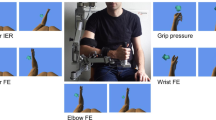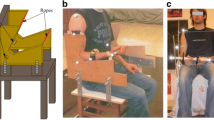Abstract
Objective
Instrumented gait analysis is widely accepted as an objective assessment of lower-extremity function. Conversely, upper-extremity function suffers from lack of objective evaluation. The present paper aims at proposing a protocol to be used to clinically and objectively evaluate upper-extremity function whatever the pathological joint. Secondly, it aims at better understanding the consequences on upper-extremity function and the compensation mechanisms induced by elbow contracture. Elbow contracture was simulated in this study by using a brace.
Design
Twelve healthy subjects followed an instrumented 3D movement analysis while performing 11 daily life movements. The movements were performed with 3 different elbow contracture conditions, simulated by wearing an adjustable elbow brace.
Results
The proposed protocol was successful in creating a wide range of motion at all the upper-extremity joints. The activity-related range of motion and the mean range of motion computed on the whole set of daily life movements were effective in evaluating the severity of elbow contracture. The lack of elbow flexion was compensated by trunk flexion, hand flexion and radial deviation, and combined movement of shoulder flexion, abduction, and humeral internal rotation. Deficit in elbow extension was mainly compensated by the use of trunk flexion.
Conclusion
A protocol could be proposed for the objective evaluation of upper-extremity function. Its application to elbow contracture suggests that loss of elbow flexion affects more movements than loss of elbow extension.




Similar content being viewed by others
References
Binkley JM, Stratford PW, Lott SA, Riddle DL. The lower extremity functional scale (LEFS): scale development, measurement properties, and clinical application. Phys Ther. 1999;79(4):371–83.
Simon SR. Quantification of human motion: gait analysis—benefits and limitations to its application to clinical problems. J Biomech. 2004;37(12):1869–80.
Van Bennekom CA, Jelles F, Lankhorst GJ. Rehabilitation activities profile: the ICIDH as a framework for a problem-oriented assessment method in rehabilitation medicine. Disabil Rehabil. 1995;17(3–4):169–75.
Dowrick AS, Gabbe BJ, Williamson OD, Cameron PA. Outcome instruments for the assessment of the upper extremity following trauma: a review. Injury. 2005;36(0020–1383):468–76.
Adams BD, Grosland NM, Murphy DM, McCullough M. Impact of impaired wrist motion on hand and upper-extremity performance. J Hand Surg Am. 2003;28(0363–5023):898–903.
O’Neill OR, Morrey BF, Tanaka S, An KN. Compensatory motion in the upper extremity after elbow arthrodesis. Clin Orthop Relat Res. 1992;0009-921X:89–96.
Cooper JE, Shwedyk E, Quanbury AO, Miller J, Hildebrand D. Elbow joint restriction: effect on functional upper limb motion during performance of three feeding activities. Arch Phys Med Rehabil. 1993;74(0003–9993):805–9.
Tang C, Roidis N, Itamura J, Vaishnau S, Shean C, Stevanovic M. The effect of simulated elbow arthrodesis on the ability to perform activities of daily living. J Hand Surg Am. 2001;26(0363–5023):1146–50.
Magermans DJ, Chadwick EK, Veeger HE, van der Helm FC. Requirements for upper extremity motions during activities of daily living. Clin Biomech (Bristol, Avon). 2005;20(0268–0033):591–9.
Kasten P, Rettig O, Loew M, Wolf S, Raiss P. Three-dimensional motion analysis of compensatory movements in patients with radioulnar synostosis performing activities of daily living. J Orthop Sci. 2009;14(1436–2023):307–12.
de Groot JH, Angulo SM, Meskers CGM, van der Heijden-Maessen HCM, Arendzen JHH. Reduced elbow mobility affects the flexion or extension domain in activities of daily living. Clin Biomech (Bristol, Avon). 2011;26(7):713–7 PMID: 21444133.
van Andel CJ, Wolterbeek N, Doorenbosch CA, Veeger DH, Harlaar J. Complete 3D kinematics of upper extremity functional tasks. Gait Posture. 2008;27(0966–6362):120–7.
Morrey BF, Askew LJ, Chao EY. A biomechanical study of normal functional elbow motion. J Bone Joint Surg Am. 1981;63(0021–9355):872–7.
Sojbjerg JO. The stiff elbow. Acta Orthop Scand. 1996;67(0001–6470):626–31.
Morrey BF, An KN, Chao EY. Functional evaluation of the elbow. In: Morrey BF, editor. The elbow and its disorders. Philadelphia: W. B Saunders; 1993. p. 86–97.
Jupiter JB, O’Driscoll SW, Cohen MS. The assessment and management of the stiff elbow. Instr Course Lect. 2003;52(0065–6895):93–111.
Bruno RJ, Lee ML, Strauch RJ, Rosenwasser MP. Posttraumatic elbow stiffness: evaluation and management. J Am Acad Orthop Surg. 2002;10(1067–151X):106–16.
Vardakas DG, Varitimidis SE, Goebel F, Vogt MT, Sotereanos DG. Evaluating and treating the stiff elbow. Hand Clin. 2002;18(0749–0712):77–85.
Jupiter JB. Assessment and management of the stiff elbow. J Musculoskelet Med. 2005;22(December 2005):692–8.
Kim PD, Grafe MW, Rosenwasser MP. Elbow stiffness: etiology, treatment, and results. J Am Soc Surg Hand. 2005;5(4):209–16.
Keschner MT, Paksima N. The stiff elbow. Bull NYU Hosp Joint Dis. 2007;65(1936–9719):24–8.
Lindenhovius AL, Jupiter JB. The posttraumatic stiff elbow: a review of the literature. J Hand Surg Am. 2007;32(0363–5023):1605–23.
Evans PJ, Nandi S, Maschke S, Hoyen HA, Lawton JN. Prevention and treatment of elbow stiffness. J Hand Surg Am. 2009;34(1531–6564):769–78.
Nandi S, Maschke S, Evans PJ, Lawton JN. The stiff elbow. Hand (NY). 2009;4(1558–9455):368–79.
Rettig O, Fradet L, Kasten P, Raiss P, Wolf SI. A new kinematic model of the upper extremity based on functional joint parameter determination for shoulder and elbow. Gait Posture. 2009;30(1879–2219):469–76.
Raiss P, Rettig O, Wolf S, Loew M, Kasten P. Range of motion of shoulder and elbow in activities of daily life in 3D motion analysis. Z Orthop Unf. 2007;145(1864–6697):493–8.
van Rijn RM, Huisstede BM, Koes BW, Burdorf A. Associations between work-related factors and specific disorders of the shoulder—a systematic review of the literature. Scand J Work Environ Health. 2010;36(1795–990X):189–201.
Palmer KT, Harris EC, Coggon D. Carpal tunnel syndrome and its relation to occupation: a systematic literature review. Occup Med (Lond). 2007;57(0962–7480):57–66.
Akbar M, Balean G, Brunner M, Seyler TM, Bruckner T, Munzinger J, Grieser T, Gerner HJ, Loew M. Prevalence of rotator cuff tear in paraplegic patients compared with controls. J Bone Joint Surg Am. 2010;92(1535–1386):23–30.
Acknowledgments
The authors would like to thank the subjects who took part in this study.
Conflict of interest
The authors declare that they have no conflict of interest.
Author information
Authors and Affiliations
Corresponding author
Electronic supplementary material
Below is the link to the electronic supplementary material.
About this article
Cite this article
Fradet, L., Liefhold, B., Rettig, O. et al. Proposition of a protocol to evaluate upper-extremity functional deficits and compensation mechanisms: application to elbow contracture. J Orthop Sci 20, 321–330 (2015). https://doi.org/10.1007/s00776-014-0679-z
Received:
Accepted:
Published:
Issue Date:
DOI: https://doi.org/10.1007/s00776-014-0679-z




